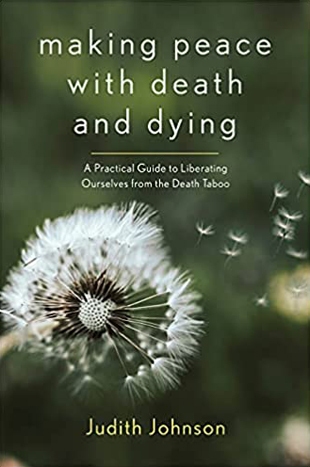Author Judith Johnson is a chaplain and interfaith minister with many years of experience counseling people on death’s door. She warns all of us that doctors don’t like to talk about death (neither do we!); it’s okay to be afraid of your death or of the death of someone else; and most of all, “Death is not optional, but love is.”
Johnson wants to remove what she calls “The Death Taboo,” meaning the common awkwardness that most of us feel being around death, near those who are dying, and talking about death. This carries “ten costs,” she explains — which include living in fear, being ill-informed and unprepared, and postponing and avoiding necessary end-of-life planning. Death is a normal part of life, she urges, and we need to begin by accepting that fact.
Insights from many psychological, religious, and spiritual teachings inform each chapter. Perhaps most of all, Johnson explains how Eastern teachings, particularly Tibetan Buddhist ones, have brought a larger understanding to how we view death and impermanence as natural parts of human life. She writes: “While I am not a practicing Buddhist, I find the Tibetan Buddhist teachings on death to be a source of great wisdom and potential liberation, particularly for those still under the influence of the Death Taboo in the West.” Quoting one of these teachers, for example, she writes, “Our fear of death, according to Sogyal Rinpoche, is the fear of life, of facing ourselves.”
The book is full of suggestions on how to be present with those who are grieving a loss or a death (see the spiritual practice link below).
There are also exercises for dying well, such as this one, on “Envisioning Your Victorious Death,” which we found most powerful and helpful:
“Gather together your favorite writing and drawing tools. Close your eyes and imagine that you are on your deathbed and there is a radiant smile on your face. You are not afraid. You know that you really gave your life your best. You feel peaceful and relaxed, regardless of any physical pain. Your beliefs are a comfort to you. Knowing that you are dying, you are curious and perhaps a little impatient to know what lies ahead. Those whom you most wish to be by your side are there with you. The music of your choice is softly playing in the background. A beautiful fragrance fills the air. Your consciousness is floating in and out. You are ready to let go of your life and loved ones. Look around at your surroundings. Where are you? Who is with you? What is going on in your mind? In your heart?”
There are forty of these sorts of exercises sprinkled throughout the chapters.
The book also excels at explaining concepts and practices that are becoming increasingly common in our lives, but are still not understood as they ought to be, such as hospice care, palliative care, healthcare proxies, Do Not Resuscitate (DNR) orders, and end-of-life decision-making.
